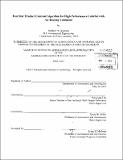Fast star tracker centroid algorithm for high performance CubeSat with air bearing validation
Author(s)
Knutson, Matthew W. (Matthew Walter)
DownloadFull printable version (10.54Mb)
Other Contributors
Massachusetts Institute of Technology. Department of Aeronautics and Astronautics.
Advisor
Sungyung Lim and David W. Miller.
Terms of use
Metadata
Show full item recordAbstract
State of the art CubeSats such as ExoplanetSat require pointing precision for the science payload on the order of arcseconds. ExoplanetSat uses dual stage control to achieve the pointing requirement. Reaction wheels provide coarse satellite attitude control while a high bandwidth piezoelectric stage performs fine optical stabilization. The optical sensor provides star images from which a centroiding algorithm estimates the star locations on the optical focal plane. The star locations are used for both the optical control loop and satellite attitude determination. The centroiding algorithm requires a short processing time to maximize the bandwidth of the fine control loop. This thesis proposes a new fast centroiding algorithm based on centroid window tracking. The tracking algorithm utilizes centroid data from previous image frames to estimate the motion of the optical sensor. The estimated motion provides a prediction of the current centroid locations. An image window is centered at each predicted star location. A center of mass calculation is performed on the image window to determine the centroid location. This proposed algorithm is shown to reduce the computation time by a factor of 10 with a novel air bearing hardware testbed. This thesis also develops a high fidelity optical imager model in MATLAB Simulink. This model can be used to test centroiding algorithms and to simulate optical systems in a spacecraft pointing simulator. The model is validated with the air bearing testbed. Furthermore, the model is autocoded to C-code which is compatible with a rapid Monte Carlo analysis framework.
Description
Thesis: S.M., Massachusetts Institute of Technology, Department of Aeronautics and Astronautics, 2012. Cataloged from PDF version of thesis. Includes bibliographical references (pages 98-100).
Date issued
2012Department
Massachusetts Institute of Technology. Department of Aeronautics and AstronauticsPublisher
Massachusetts Institute of Technology
Keywords
Aeronautics and Astronautics.